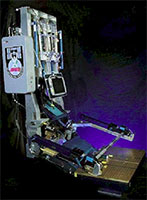Nov 11 2008
Space shuttle mission STS-126 is set to make some major changes to the International Space Station that will result in the ability to support twice the crew currently living there.
 New gym equipment for the ISS, also known as advanced Resistive Exercise Device,(aRED)
New gym equipment for the ISS, also known as advanced Resistive Exercise Device,(aRED)
STS-126’s main purpose is to get the station ready for the expansion of the ISS, and space shuttle Endeavour is bringing with it a multi-purpose logistics module loaded with about 32,000 pounds of equipment with which to do so.
“It’s the most jam-packed logistics module we have ever carried up there,” STS-126 Commander Chris Ferguson said. “We’re taking a three-bedroom, one-bathroom house and turning it into a five-bedroom, two-bathroom house with a gym.”
Outside the ISS spacewalks will performed to fix the solar alpha rotary joints that allow the electricity-generating solar arrays to rotate so that they’re always getting as much sun as possible.
Back inside, the crew will spend a lot of time unpacking new crew quarters, a new toilet, a new kitchen, a new refrigerator and new exercise equipment, not to mention the science experiments.
“We’re going to use up a lot of the new space that we’ve brought up on the past few missions, with Node 2 and Columbus and the Kibo module,” lead shuttle flight director Mike Sarafin said. “The six-person crew is an important step toward utilizing the space station to its full capability.”
But in addition to fully utilizing the space station, the equipment brought up will allow the space station to start depending less on the space shuttle. A new regenerative environmental control and life support system will give the station the ability to recycle urine and the condensation that the crew breathes into the air into pure water that can be used for drinking or to cool the station’s systems.
That will be important when the shuttle fleet is retired in 2010, and its water deliveries dry up.
“Up until this point, the majority of the station’s drinking water was coming up from the shuttle or the Russian’s Progress vehicle,” Sarafin said. “This sets us up for long-term sustainability of the station without the shuttle.”
Nobody will be drinking the water generated by the system just yet – an onboard purity monitor needs to be checked out and multiple water samples must be analyzed by scientists on the ground first. To get that water sample home as quickly as possible, Endeavour’s crew will take a shot at getting the system hooked up before they leave. If they’re able to do so, it will be no small feat.